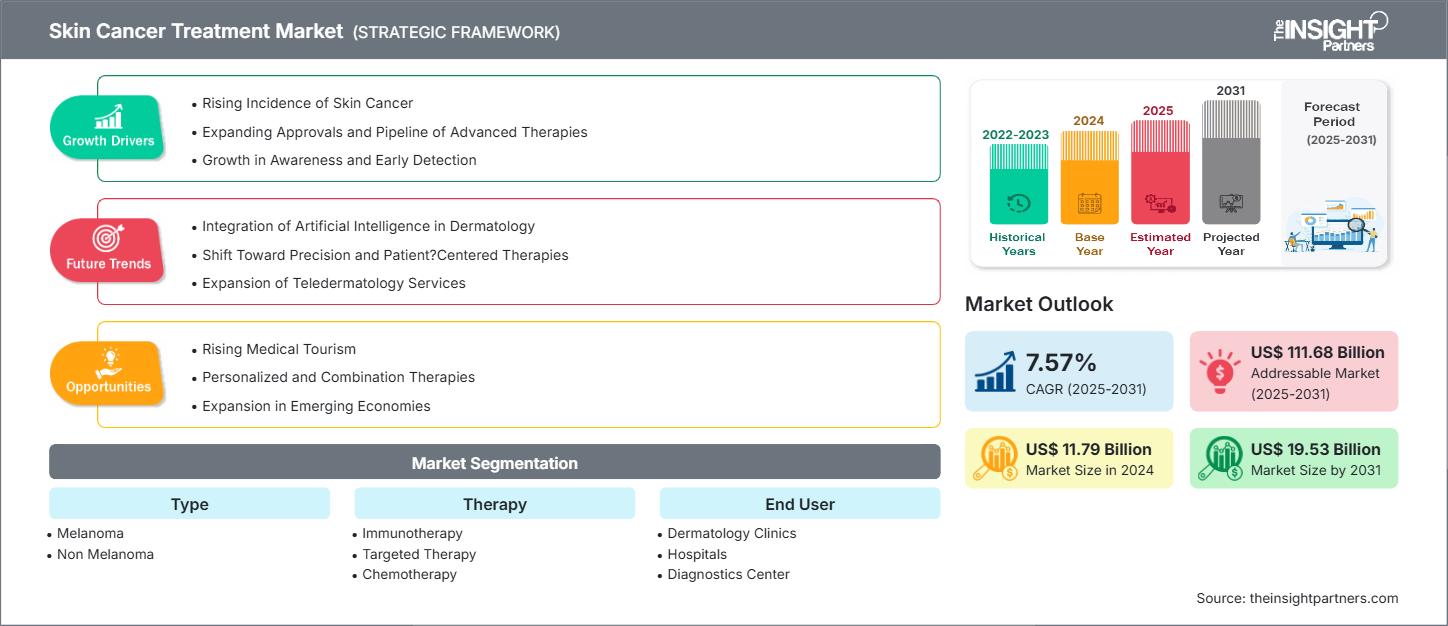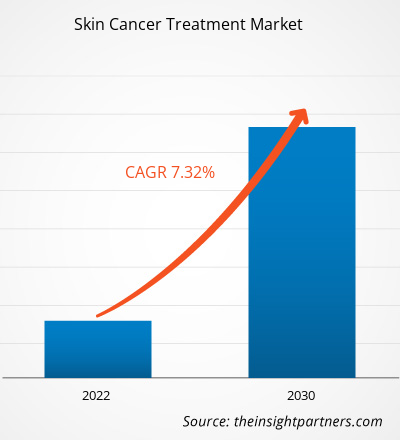皮肤癌治疗市场规模预计将从 2024 年的 117.9 亿美元增至 2031 年的 195.3 亿美元。预计 2025 年至 2031 年期间该市场的复合年增长率将达到 7.57%。
皮肤癌治疗市场分析
皮肤癌发病率的飙升,以及不断增长的获批和强大的先进疗法研发管线,正在推动皮肤癌治疗的应用。根据美国癌症协会的数据,2025年美国新增黑色素瘤病例约212,200例,其中原位黑色素瘤107,240例,侵袭性黑色素瘤104,960例,位列第五大常见癌症。黑色素瘤等皮肤癌发病率的上升,催生了对检查点抑制剂等先进疗法的需求。此外,个性化疗法和联合疗法的普及也为皮肤癌治疗市场带来了巨大的机遇。
皮肤癌治疗市场概览
预计北美将占据皮肤癌治疗市场的最大份额,而亚太地区预计将在预测期内实现显著的复合年增长率。该地区涵盖中国、日本、印度、韩国、澳大利亚以及更广泛的亚太地区等主要市场,并在整个亚太地区的增长中占据重要地位。一些亚洲国家的皮肤癌发病率低于西方国家,这可能是由于其人口黑色素构成较高。中国国家癌症中心2024年的报告指出,基底细胞癌和鳞状细胞癌的发病率正在上升,尤其是在福建和广东等沿海省份。
澳大利亚健康与福利研究所 (AIHW) 报告称,2023 年,超过 110 万澳大利亚人根据医疗保险福利计划 (MBS) 接受了非黑色素瘤皮肤癌治疗。该报告还提到,2022 年黑色素瘤导致约 15,000 例新发病例和超过 1,300 例死亡。
据日本国家癌症中心报道,日本黑色素瘤病例呈稳步上升趋势,尤其是在老年人群体中。根据2024年癌症登记处的最新数据,皮肤癌是日本20种常见癌症之一,且发病率呈上升趋势,尤其是在60岁及以上的男性群体中。
您可以免费定制任何报告,包括本报告的部分内容、国家级分析、Excel 数据包,以及为初创企业和大学提供优惠和折扣
皮肤癌治疗市场:战略洞察

-
获取此报告的顶级关键市场趋势。此免费样品将包括数据分析,从市场趋势到估计和预测。
皮肤癌治疗市场驱动因素和机遇
市场驱动因素:
-
扩大先进疗法的审批和研发渠道:
不断扩大的审批和强大的先进疗法渠道,包括新的免疫疗法和靶向治疗方案,为晚期或侵袭性皮肤癌患者提供了更多选择。 -
皮肤癌发病率上升:
黑色素瘤和非黑色素瘤皮肤癌病例的不断增加,推动了皮肤癌治疗市场的增长。皮肤癌病例的稳步增长正成为推动市场增长和多元化的主要因素之一。 -
提高早期检测意识:
皮肤癌,尤其是黑色素瘤,如果及早发现,治愈率很高。及早发现可以采取创伤更小、更有效的治疗方法,例如手术切除。
市场机会:
-
新兴经济体的扩张:由于皮肤癌病例数量的增加和对早期发现的认识的提高,亚太地区、拉丁美洲和非洲的几个国家在皮肤癌治疗市场提供了增长机会
。 -
医疗旅游的兴起:
中国、印度、印度尼西亚、巴西和墨西哥等发展中国家的医疗旅游业日益繁荣,为人们提供了价格实惠的先进护理和治疗,价格比美国和欧洲国家低 50-70%。 -
个性化和联合治疗:
公共医疗计划资助的新辅助免疫疗法(手术前)等先进疗法可以显著改善高危患者的生存结果。
皮肤癌治疗市场报告细分分析
为了更清晰地了解皮肤癌治疗市场运作方式、增长潜力和最新趋势,我们将市场细分为不同的细分领域。以下是大多数行业报告中使用的标准细分方法:
按类型:
-
黑色素瘤:
黑色素瘤是第二大癌症类型,其主要原因是全球黑色素瘤发病率的上升。世界卫生组织报告称,2022年全球每年新增黑色素瘤皮肤癌病例约33万例。 -
非黑色素瘤:
非黑色素瘤皮肤癌比黑色素瘤皮肤癌更常见。非黑色素瘤包括默克尔细胞癌、基底细胞癌和鳞状细胞癌。这些癌症可通过手术完全治愈,且很少致命。
按治疗类型:
-
免疫疗法:
临床数据显示,帕博利珠单抗等免疫疗法为晚期黑色素瘤患者提供了约 34% 的 5 年总体生存率,与旧方法相比有了显著改善。 -
靶向治疗:
靶向治疗比传统的化疗更进了一步,它攻击的是导致癌细胞生长的特定分子通路。最具突破性的成果是发现了BRAF基因突变,这种突变存在于大约40%至60%的黑色素瘤病例中。 -
化疗:
化疗的主要目的是利用对细胞有毒性的药物消灭快速分裂的癌细胞。然而,与靶向疗法不同,化疗无法区分健康细胞和癌细胞。因此,化疗会带来许多不良反应。 -
放射治疗:
就皮肤癌而言,不适合手术或全身治疗的患者可以从放射治疗中获益。对于晚期或无法手术的肿瘤,放射治疗也能起到缓解疼痛、出血或梗阻等症状的姑息作用。 -
其他的:
此外,还有其他材料,例如氯丁橡胶和聚异戊二烯。氯丁橡胶广泛用于制造手术手套,提供出色的保护屏障以及合适的贴合度和手感。
按最终用户:
- 皮肤科诊所
- 医院
- 诊断和癌症护理中心
- 其他的
按地域划分:
- 北美
- 欧洲
- 亚太地区
- 拉美
- 中东和非洲
北美皮肤癌治疗市场预计将占据相当大的市场份额。越来越多的外科手术和市场参与者的业务扩张策略可能是推动市场发展的因素。
皮肤癌治疗市场区域洞察
Insight Partners 的分析师已详尽阐述了预测期内影响皮肤癌治疗市场的区域趋势和因素。本节还讨论了北美、欧洲、亚太地区、中东和非洲以及南美和中美洲的皮肤癌治疗市场细分和地域分布。
皮肤癌治疗市场报告范围
| 报告属性 | 细节 |
|---|---|
| 2024年的市场规模 | 117.9亿美元 |
| 2031年的市场规模 | 195.3亿美元 |
| 全球复合年增长率(2025-2031) | 7.57% |
| 史料 | 2022-2023 |
| 预测期 | 2025-2031 |
| 涵盖的领域 |
按类型
|
| 覆盖地区和国家 |
北美
|
| 市场领导者和主要公司简介 |
|
皮肤癌治疗市场参与者密度:了解其对业务动态的影响
皮肤癌治疗市场正在快速增长,这得益于终端用户需求的不断增长,而这些需求的驱动因素包括消费者偏好的转变、技术进步以及对产品益处的认知度的提升。随着需求的增长,企业正在扩展产品线,不断创新以满足消费者需求,并抓住新兴趋势,从而进一步推动市场增长。

- 获取皮肤癌治疗市场顶级关键参与者概述
皮肤癌治疗市场份额(按地区)分析
预计未来几年亚太地区将实现最快的增长。拉丁美洲、中东和非洲等新兴市场也为皮肤癌治疗提供商提供了许多尚未开发的扩张机会。
各地区皮肤癌治疗市场的增长情况各不相同。这归因于慢性病患病率上升、外科手术增多以及感染控制策略采用率提高等因素。以下是各地区市场份额和趋势的总结:
1. 北美
-
市场份额:
占据全球市场的很大份额 -
关键驱动因素:
- 由于某些地区过度暴露于紫外线辐射,黑色素瘤和其他皮肤癌的发病率很高。
- 存在完善的治疗方案,包括免疫疗法和靶向疗法。
- 高昂的医疗支出和结构化的报销框架也引人注目。
-
趋势:
个性化医疗的使用日益增多,新生物制剂和治疗药物的开发和大力投资,以及新药研发的充足资金。
2.欧洲
-
市场份额:
相当一部分市场归功于先进的医疗保健和新疗法的快速应用 -
关键驱动因素:
- 非黑色素瘤和黑色素瘤皮肤癌病例数量不断增加。
- 政府对癌症认知和筛查计划的积极举措。
- 拥有先进的放射治疗技术和临床试验网络。
-
趋势:
专注于精准肿瘤学、联合治疗方法(免疫疗法+靶向疗法)以及人工智能在皮肤病诊断中的整合
3. 亚太地区
-
市场份额:
增长最快的地区,市场份额逐年上升 -
关键驱动因素:
- 中国、印度和东南亚的医疗保健基础设施迅速改善。
- 由于户外活动增多和防护措施有限,患者人数不断增加。
- 增加政府对癌症治疗的资助并扩大保险覆盖范围。
-
趋势:
为寻求可负担的癌症治疗、利用后现代诊断成像工具以及加强与国际制药公司的合作而进行的医疗旅行有所增加。
4.南美洲和中美洲
-
市场份额:
发展中市场持续增长。 -
关键驱动因素:
- 皮肤癌发病率不断增加,尤其是在巴西和智利等紫外线指数较高的地区。
- 扩大皮肤病学专家和癌症护理中心的覆盖面。
- 进口先进的皮肤癌药物和设备。
-
趋势:
更加注重宣传活动、可负担治疗的医疗旅游以及免疫疗法逐步进入当地市场。
5.中东和非洲
-
市场份额:
虽然规模小,但增长迅速 -
关键驱动因素:
- 利用政府资金支持扩大医疗保健基础设施。
- 加强对癌症预防和早期发现的宣传活动。
- 加强与全球制药公司的合作以扩大临床试验。
-
趋势:
政府支持的皮肤癌预防举措、对先进肿瘤中心的投资以及远程皮肤病学在远程诊断中的应用日益广泛。
皮肤癌治疗市场参与者密度:了解其对业务的影响高竞争和高密度市场
市场密度高,竞争激烈
赛诺菲、阿斯利康和礼来等知名公司之间的竞争十分激烈。太阳制药工业有限公司(亚太区)和武田制药(亚太区)等区域性和利基供应商也加剧了不同地区的竞争格局。
这种激烈的竞争促使公司通过提供以下产品脱颖而出:
- 高级产品
- 定制和可持续解决方案等增值服务
- 有竞争力的定价模式
- 遵守监管准则
机遇与战略举措
- 专注于开发和临床研究新型联合疗法。
-
公司正在转向局部疗法和光动力疗法等非侵入性疗法,以减少恢复时间和副作用
- 成熟公司与生物技术公司、学术研究机构和医疗保健提供商合作,以加速治疗方法的开发及其临床应用。
在皮肤癌治疗市场运营的主要公司包括:
- 默克公司
- 辉瑞公司
- 诺华公司
- 百时美施贵宝公司
- 安进公司
- 霍夫曼-罗氏公司
- 再生元制药公司
- 葛兰素史克公司
- Iovance生物治疗公司
- 基因泰克公司
免责声明:以上公司排名不分先后。
研究过程中分析的其他公司:
- 赛诺菲
- 太阳制药工业有限公司
- 礼来公司
- 阿斯利康公司
- 武田药品工业株式会社
- 益普生制药
- 瓦里安医疗系统公司
- 协和麒麟株式会社
- 医科达公司
- Aqua制药公司
- iCAD 公司
- AB 科学
- Cellceutix公司
- 卫材株式会社
- 大冢制药株式会社
皮肤癌治疗市场新闻和最新发展
- 美国食品药品监督管理局批准 Opdivo(nivolumab)作为完全切除的 IIB 期或 IIC 期黑色素瘤患者的辅助治疗。
- 诺华与 Erasca 签署了价值 2000 万美元的许可协议,将纳普拉非尼黑色素瘤疗法带入中期开发阶段。
皮肤癌治疗市场报告覆盖范围和交付成果
《皮肤癌治疗市场规模和预测(2021-2031)》报告对以下领域进行了详细的市场分析:
- 皮肤癌治疗市场规模以及涵盖范围之内所有关键细分市场的全球、区域和国家层面的预测
- 皮肤癌治疗市场趋势以及市场动态,如驱动因素、限制因素和关键机遇
- 详细的 PEST 和 SWOT 分析
- 皮肤癌治疗市场分析涵盖主要市场趋势、全球和区域框架、主要参与者、法规和最新市场发展
- 行业格局和竞争分析,包括市场集中度、热图分析、知名参与者以及皮肤癌治疗市场的最新发展
- 详细的公司简介
- 历史分析(2 年)、基准年、预测(7 年)及复合年增长率
- PEST和SWOT分析
- 市场规模、价值/数量 - 全球、区域、国家
- 行业和竞争格局
- Excel 数据集
近期报告
相关报告
客户评价
购买理由
- 明智的决策
- 了解市场动态
- 竞争分析
- 客户洞察
- 市场预测
- 风险规避
- 战略规划
- 投资论证
- 识别新兴市场
- 优化营销策略
- 提升运营效率
- 顺应监管趋势






















 获取免费样品 - 皮肤癌治疗市场
获取免费样品 - 皮肤癌治疗市场